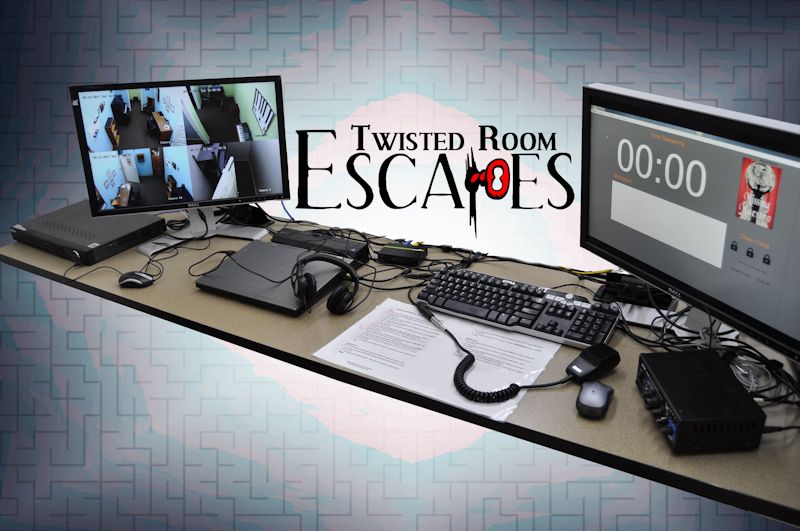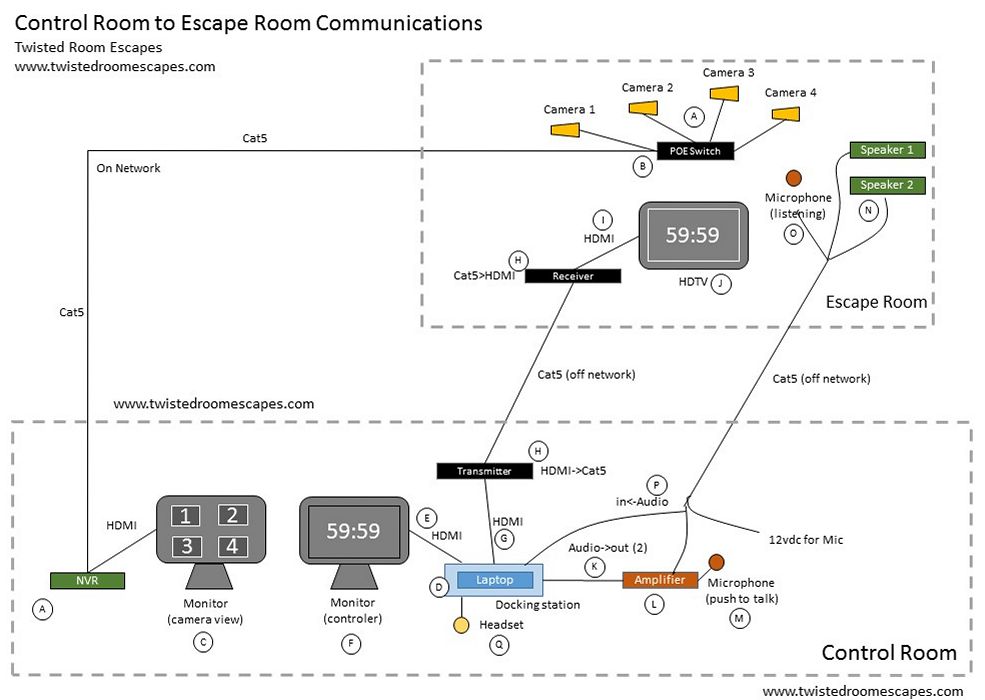Control Room to Escape Room Communications
05/13/2017

At Twisted Room Escapes, we have settled on a setup that works very well.
Three Cat-5 wires are used to connect the control room to the escape room. Only one Cat-5 wire is hooked into the network, the others are used off network. In this setup, no WiFi is used, only hardwired connections.
IP Cameras with an NVR are used as the camera system. A POE Switch is located in the escape room to power the cameras and make the network connection. The NVR is used to output to a monitor in the control room. Update: We found that the POE Switch setup works, but can confuse the camera system by generating IP conflicts depending on the brand that use use. Hardwiring the cameras using a separate Cat-5 wire for each gave us a more stable setup.
A laptop with a docking station is used to run the timer/control room software. A docking station is used to allow the connections to two output monitors. The use of a real keyboard is also one of the considerations of using a laptop.
The docking station has 2 DVI outputs. Alternatively the laptop monitor could be use as one of the displays.
The laptop is setup to display in Duplicate mode, displaying the same output to both monitors.
An HDMI extender over Cat-5 is used to connect the laptop to the HDTV (monitor) in the escape room.
We feel it is important that the control room display and the HDTV in the escape room show exactly the same screen. Our control room software, setup, and interactions with the participants is very indiscrete (explained in the control room software section). The last thing we wanted was not knowing what the game participants are seeing or not seeing.
The audio OUT of the laptop is directed into an amplifier. The Amplifier is connected to speakers in the escape room. The connection is made using 4 (for stereo) wires from the Cat-5 cable. A push to speak CB style handset is plugged into the amplifier. The amplifier has separate volume controls for line out and microphone. The amplifier allows the control room software to play music, outputting to the speakers in the escape room. The amplifier allows the game master to speak over the speakers using the CB style handset (microphone).
A listening microphone is placed in each room. It is connected to the Cat-5 (remaining 4 wires). 2 wires for the microphone and 2 wires for power). The microphone wires are connected into the audio IN of the laptop. A USB headset is used to listen to the participants of the room. Alternatively, the headset microphone can be used to speak to the participants in the escape room. However, we have found that game master chitchat can be overheard by the game participants and that the CB style handset (push to talk) is a better solution. Update: We found that putting the microphone input into the laptop works, but directly connecting the input into a set of headphones is easier. A 3.5MM female stereo jack plug wired to send output to both stereo channels works better. A standard pair of headphones can then be plugged in. The microphone volume level that is outputted is fine. Having the female stereo jack plug also allows to output to an external speaker easiiy. A standard splitter can be used as well to output to both headphones and speaker.
The setup allows for the game master to hear everything in the room, including the music and video sounds being played by the game room software and also allows the game master to speak to participants in the room. One way messaging through the software is done by the game master.
Our game master / control room software has been added to a GitHub repro and can be downloaded and used under GNU General Public License v3.0. See the specifics about the software on this project page - Game Master Software
The diagram below depicts the setup. The list of components are lettered A-Z.

A. LaView IP 1080P HD 4 Camera 8CH NVR
B. (optional) TRENDnet 5-Port Unmanaged 10/100 Mbps PoE Switch with 4 PoE Ethernet Ports
If you are connecting the DVR to the cameras directy (1 wire to 1 camera using CAT5 PoE, then you won't need the PoE switch).
C. 24” Monitor
D. Laptop with Docking station (2 DVI outputs)
E. DVI to HDMI cable to control room monitor
F. 24” Monitor
G. DVI to HDMI cable to HDMI extender
H. HDMI Extender Over Ethernet (Transmitter & Receiver)
I. HDMI cable to HDTV in Escape Room
J. 32” HDTV
K. Audio OUT from laptop to Amplifier
L. Pyle 2x120 Watt Stereo Power Amplifier PA/Microphone
M. Push-to-Talk CB/Handheld Microphone with Phone Plug
N. 2 Speakers
O. VideoSecu High Sensitive Pre-amp Audio Pickup Device Tiny Spy Microphone
P. Microphone audio IN to laptop. Note, this is a MONO connection.
Q. Logitech USB Headset H390
Considerations
Have duplicates on hand. Any equipment that you use, carry a spare.
Consistency. For each room, use the exact same setup. The last thing you want is mixed and matched hardware that has problems and no one to know how to fix them. If each escape room setup has the same setup, it is easier for game masters to trouble shoot when problems arise. It is easy to create a trouble shooting manual for employees. In our setup, we can swap a monitor or amplifier and even a laptop and be up in minutes.
Use multiple microphones when the escape room has multiple rooms. The microphones can be tied together to run off the same line IN and power. Bu sure the wires connections match.
An external speaker can be used in conjunction with the listening headset. An audio splitter can be used on the microphone IN, splitting audio into the laptop and also to an external, amplified speaker. Note, the microphone IN is a MONO connection. You can buy a mono to stereo adapter if so desired.